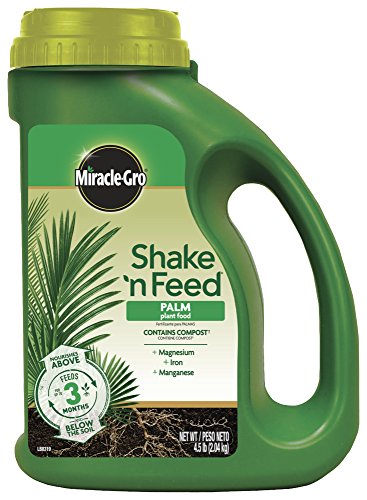
Palms are evergreen shrubs, trees, or vines in the Arecaceae family, suited to cultivation in Zones 6 to 13, depending on the species.
Mature dimensions range from two to 200 feet tall and up to 40 feet wide. Many types grow well indoors as houseplants.

We link to vendors to help you find relevant products. If you buy from one of our links, we may earn a commission.
Our guide to growing palm trees has all you need to know to enjoy the tallest varieties in your outdoor living space.
This article discusses how to fertilize palms for the healthiest plants.
Here’s what we’ll cover:
Tips for Fertilizing Palms
First let’s talk about these plants and the environment in which they grow.
Cultural Requirements
True palms, plants in the Arecaceae family, are more closely related to grasses than to trees. Instead of wood, they have tear-resistant fibers that bend without breaking.
Such resistance is essential, as their roots are shallow; without it, they would be vulnerable to uprooting in the windy tropical storms of their native lands.

Unlike branched trees, plants in this family have one apical meristem or growing point from which all foliage, flowers, and fruits emerge.
Single-stemmed species are likely to suffer more extensive, visible, and potentially fatal damage from a nutrient deficiency than branched types.
As landscape specimens, true palms prefer full sun to part shade.
The ideal soil is loose, sandy loam with a slightly acidic to neutral pH of 5.5 to 7.5, that drains well. Unfortunately, many sandy seaside locales lack essential soil nutrients.
Essential Nutrients
Nutrients crucial to successful palm cultivation include the “big three” macronutrients nitrogen (N), phosphorus (P), and potassium (K), as well as the micronutrients boron (B), iron (Fe), manganese (Mn), and magnesium (Mg).
Arecaceae species don’t require a lot of boron, but without it, the leaves may appear stunted and irregular, the stems may exhibit growth anomalies, and buds may die.
The addition of boron in small quantities improves symptoms.
High alkalinity, planting too deeply, and soil compaction may all contribute to iron deficiency. Symptoms include chlorosis (leaf yellowing), browning of the leaf tips, and reduced leaf size.
Foliar applications of a chelated (bonded for stability) iron fertilizer help restore health and alleviate symptoms, but it is important to address the soil pH and compaction as well.
The most likely nutritional deficiency in potted specimens is nitrogen. Common in nutrient-poor sandy soil, it causes pale green foliage and stunted growth.
A slow-release nitrogen product should restore color.

Magnesium, manganese, and potassium deficiencies are common in palms growing in the landscape.
When lacking in magnesium, the oldest leaves display yellow edges with green centers. If the plants are also potassium deficient, the leaf tips turn brown.
Applying magnesium sulfite and potassium will not restore affected foliage but may prevent new symptoms. For growing environments with overly acidic soil, amending with limestone may result in improvement.
Excess phosphorus, high alkalinity, inadequate drainage, and poor sandy soil can cause manganese deficiency serious enough to kill a plant.
Symptoms of lack of manganese include yellowing between the leaf veins and new foliage emerging discolored and with abnormal, stunted growth.
Increasing soil acidity and applying manganese sulfate may resolve the issue.
Achieving Optimal Nutrition
According to the experts at Clemson University, regular fertilization with a product formulated specifically for Arecaceae species is the best way to support optimal nutrition and avoid disfiguring and potentially lethal nutrient deficiencies.
They recommend four applications during the spring to fall growing season, based on a University of Florida study, which determined that a product with an N-P-K ratio of 8-2-12 with four percent magnesium and added micronutrients, in a slow-release granular form, helps treat and prevent essential nutrient deficiency.
It’s always a good idea to conduct a soil test to find out if there are any specific deficiencies in your landscape.
You can do this through your local agricultural extension office or with a home test kit. When you have the results of your soil test you can amend accordingly.
How to Fertilize
After recognizing the need to fertilize and the composition of nutrients to apply, it’s time for one last essential point – how to apply a product.

Be sure to read all package instructions of the product you have chosen. Foliar spray applications for large trees are best left to a professional.
For slow-release granular formulations:
Clear an 18- to 24-inch ring of ground around your shrub or tree. This area is the root zone.
Turf and weeds should be removed from the root zone, and nothing should touch the stem or stems of your palm.
In addition to inhibiting drainage, grass and weeds may harbor pests and disease and expose the stems to turf and weed treatment chemicals.
Moisten the root zone. Sprinkle the granular product onto the soil in the root zone, but don’t allow it to touch the stems. Water well after application.

For houseplants, sprinkle granules in a ring around the perimeter of the plant without allowing it to touch the stems.
Where to Buy
Some regions have rules prohibiting or limiting fertilizer use, so if in doubt, consult your local agricultural extension before implementing a feeding regimen.
This Miracle-Gro product has the recommended 8-2-12 (NPK) ratio, and also includes compost, iron, magnesium, and manganese in addition to the main macronutrients.
Miracle-Gro Shake ‘n Feed for Palms
You can find it available in four-and-a-half-pound jugs via Amazon, or for more extensive landscape use, 20-pound bags can be purchased at Home Depot.
A Tropical Paradise
When palms have all of their cultural requirements met and receive regular fertilizer applications, they are a beautiful addition to the landscape or your interior decor.

Test your soil to determine its nutritional makeup, and start a regular fertilization program to support the health of the plants in your tropical paradise.
Do you grow palms in your landscape? If so, how do you feed them? Please tell us in the comments section below.
If you found this article helpful and want to read more about palm care, we recommend the following guides next:






